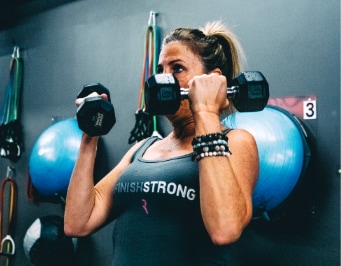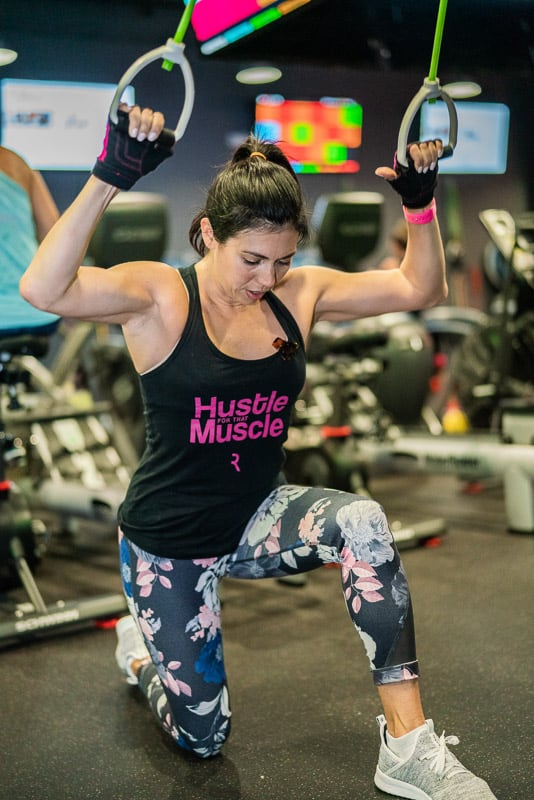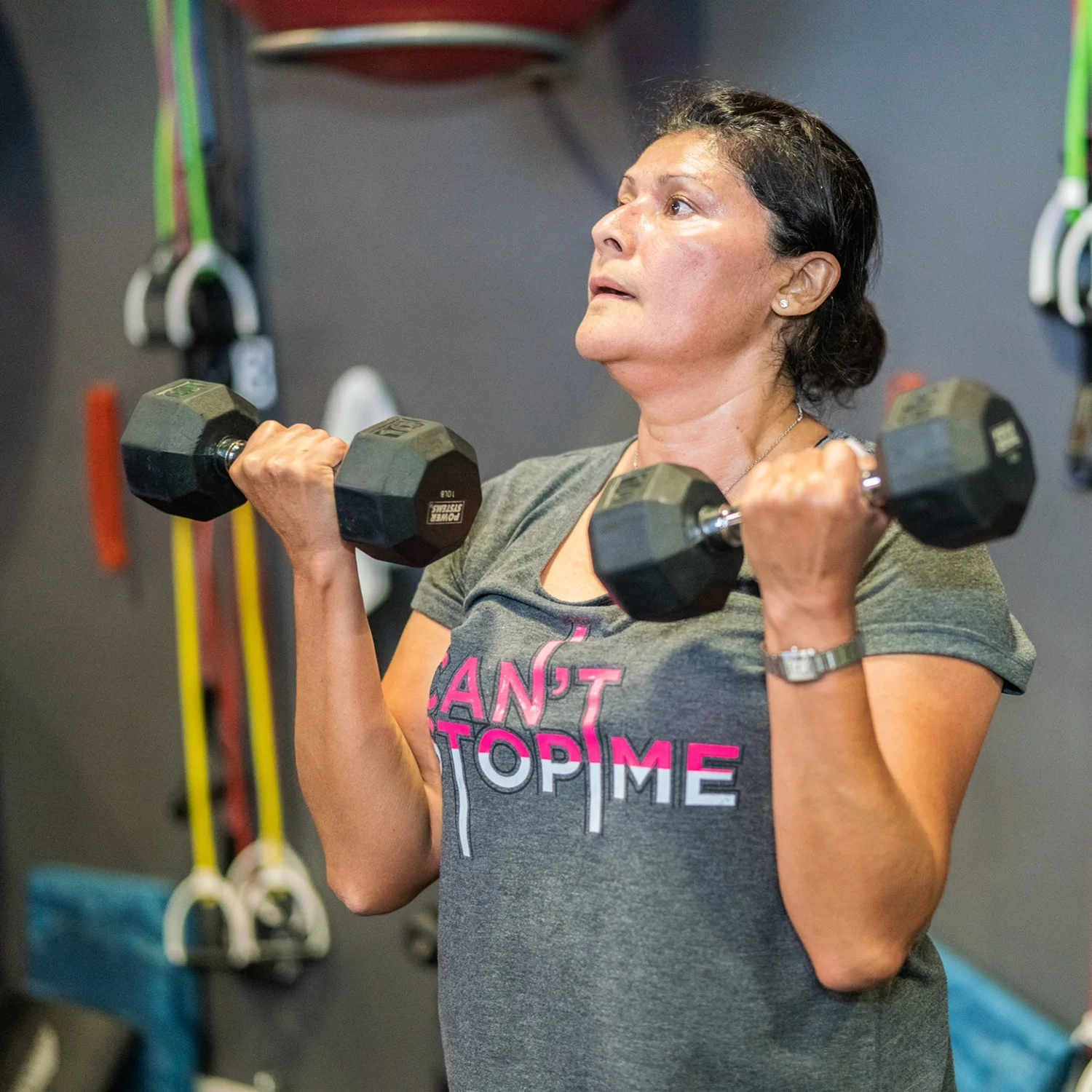Ask 100 women this year what their New Year’s resolution will be and a third will likely answer “weight loss” in to look fitter and more toned. Many of these women will join a gym (or actually start using their membership) and center their workout around high-intensity sessions on the treadmill, elliptical, or any other cardio machine. Running on the treadmill 4 days a week may help you lose body fat, but without adding on muscle, it won’t give you that tight, toned look.
Strength training by utilizing some form of resistance is a much better approach than focusing only on cardio if your goal is to achieve a toned, healthy physique, and there’s a lot of science to support it. Research shows that adding resistance training as part of your workout routine is a proven method for increasing Lean Body Mass and reducing body fat for women.
Read on to learn everything you need to know about strength training. We’ll separate fact from fiction, look at additional benefits of resistance training, learn how much training you need. In the end, we hope to encourage some of you who are on the fence about strength training to get on board and start experiencing its many benefits.
Three Myths About Why Women Should Avoid Strength Training
There are a lot of myths and misconceptions out there about strength training. They encourage many women to disregard or dismiss any training involving weights or resistance. Let’s dispel three common myths and put them to rest.
Myth #1: Weightlifting causes women to “look bulky”
Let’s get this one out of the way straight out of the gate.
Many women associate resistance training as bad and something only men should do because they believe it leads to weight gain and a “bulky look.”
Here’s the truth about strength training: yes, it may cause you to gain weight. In fact, you can probably count on it. But that’s perfectly okay, and here’s why: if the gains you experience are gains in Lean Body Mass, this means your weight can stay the same, or even increase, but you will look more lean and toned.
Muscle is denser than fat, meaning it takes up less space on your body. By losing fat and gaining muscle, you can stay the same weight – or even gain some – but actually be slimmer than you were before. Think of weight training as an investment that pays serious dividends down the road. The more muscle you have, the more calories (and fat) your body can burn over time.
“Healthy” is not a number on the scale—it’s how you look and feel.
So don’t think in terms of what you want to lose and focus more on what you want to gain, both physically and emotionally.
Please, etch this thought deep into your brain: as long as you’re noticing positive changes in how you look and feel, that arbitrary number on the scale doesn’t make a bit of difference. In fact, it’s likely to lead you astray.
Myth #2: Lifting huge and heavy is required
When you take a look around the gym and at the people who are lean and muscular, you often see them – especially the men – squatting what looks like an unbelievable amount of weight: 2, 3, even 4 plates on each side of the barbell. That can be intimidating.
Good news: first of all, lifting heavy with low reps is just one style of strength training, and secondly, if you’re just trying to tone up and have no desire to look like a bodybuilder, it’s not necessary.
A study on women found that regardless of what the training style was – heavy lifting with low reps or low weights with high reps – strength and muscle gains occurred.
This means you don’t have to deadlift 2x your bodyweight or curl dumbbells the size of your head in order to reap benefits. Strength training at whatever level you’re comfortable with yields positive results, and if an attractive, toned look motivates you, you will be able to work towards that goal with low/moderate resistance exercise.
Myth #3: You can be too old to weight training
“Sarcopenia” is the gradual loss of muscle mass that begins for most women after age 35.
Contrary to popular belief, this decline in muscle mass and strength is not a result of the aging process; rather, it’s due to inactivity.
However, current dogma around resistance training among elderly women has been a barrier. Researchers Stuart Phillips and Richard Winett wrote:
Few would argue that some form of resistance training should not be part of a complete exercise program; however, the bulk of literature on the cardio-protective effects of aerobic exercise has continued to make this form of exercise preeminent and the central focus of many physical activity guidelines in Canada, the United States, and many other countries.
If you’re an older adult, you don’t need to fall for the “adults shouldn’t lift” myth.
Studies show that resistance training is the best way to prevent and reverse loss of muscle for older adults. For women, in particular, resistance training is an effective long-term strategy to preserve muscle and positive changes in body composition.
The science is clear: improving your muscle mass is something anyone can (and should) do.
Additional Benefits of Strength Training for Women
Aside from improving your body composition by increasing Lean Body Mass, there are several other benefits of strength training in addition to muscle growth and looking fitter.
Healthier Bones and Joints
Women who don’t exercise can lose anywhere from 3 to 8% of their muscle mass each decade as a result of inactivity. Studies show that doing strength training can promote bone development, reduce lower back pain, and reverse several skeletal muscle aging factors.
Strength training is not only good for your muscles, it can help ease the pain in your joints and keep your prevent bone loss.
Reduced anxiety
If you’re looking for a way to chill out and relieve some stress and anxiety, try lifting weights!
There’s a strong correlation between resistance training and stress reduction/anxiety. According to research, resistance training at a low-to-moderate intensity (<70% 1 repetition maximum)is best for reducing anxiety.
Improved body image
Perhaps one of the biggest benefits of resistance training is that it can also help you feel better about yourself. According to one study, weight training is associated with “significant improvements in several dimensions of body image, health-related quality of life, and physical activity behaviors, satisfaction, and comfort.”
How Many Resistance Workouts Do You Need A Week?
Both the Centers for Disease Control and Prevention (CDC) and the American Heart Association (AHA) recommend 2 or more days per week of total body resistance workouts that work all major muscle groups alternating between the lower body (legs, hips, back, abdomen) and upper body (chest, shoulders, and arms) for all adults.
The National Institutes of Health (NIH) says adults over 65 should follow these same guidelines unless you have a chronic condition (heart disease, lung disease, or diabetes). In these cases, ask your doctor what types and amounts of activity are safe.
For postmenopausal women, researchers recommend doing resistance and weight bearing based workouts three days a week (on alternate days).
If you’re a newbie, start by adding one workout a week that uses resistance bands and light dumbbells and work your way up from there.
Ready for your turn?
Contrary to popular belief, the “tight and toned” look many women want is achieved by both a mix of cardio workouts and strength training.
Remember that how you frame your exercise goals is important. So stop thinking in terms of what you want to lose and focus more on what you want to gain (both physically and emotionally).
You can set better goals too: If you set a goal of gaining Lean Body Mass instead of losing weight, you’ll be able to measure the results of your resistance training efforts in terms of lean mass gained instead of pounds lost, which can be quite empowering because it relieves you from caring about what the scale says about your body weight.
So where do you start … or how do you improve your current resistance training efforts? Setting body composition goals is a good place to start. Once you’ve done that, work with a certified personal trainer at a local fitness center to show you how to perform resistance training exercises, like the dumbbell squat variations, with proper form.
Make functional strength training a part of your lifestyle, and you will experience noticeable results to how you look and feel.
If you’re a woman who hasn’t tried strength training or aren’t getting the results you wanted from her workouts, now’s the perfect time to jump on the bandwagon, or rather, pick up the dumbbells.
***
Scott Christ is a health and wellness entrepreneur, writer, and website strategy consultant. He’s also the creator of the world’s healthiest plant-based protein powder




You must be logged in to post a comment.